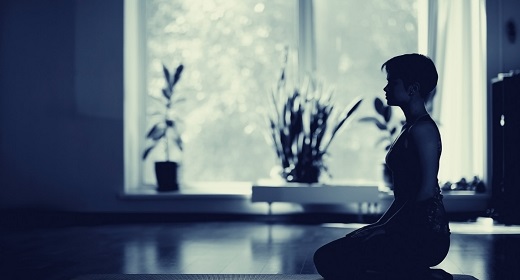Many individuals believe that yoga blocks can be useful when practicing yoga as a means to improve balance…
While this is true, there are many other uses for yoga blocks (one of a variety of yoga propsavailable) that can help both beginners and yoga instructors alike improve their yoga practice. To help you understand how to use yoga blocks to improve your performance no matter what your skill level is, in a yoga class or at home, use this guide to help you uncover what yoga blocks are, the benefits of using yoga blocks to improve your practice, and how to use yoga blocks.
What Are Yoga Blocks?
Blocks are yoga props that can be integrated into yoga practice. Yoga blocks are square in shape and resemble a brick. Though yoga blocks are available in a variety of different sizes, a standard yoga block size is 9 x 6 x 4 inches in size. The benefit of this size of yoga block is that it allows for three different heights, which allows you to adjust the block height as your practice progresses or depending on the pose you are using the yoga block for. A yoga block must be capable of supporting your weight; many of them are made out of foam or cork.
Foam yoga blocks are often the most cost-effective option, though they deteriorate faster and stain more easily than their cork counterparts. While cork yoga blocks may cost more initially, they often last longer. In addition, cork is a natural antimicrobial, which means that it naturally kills bacteria.
Some individuals mistakenly believe that using a prop is a sign of weakness when practicing yoga, but props can be a beneficial addition both to individuals who are experienced or just beginning to practice yoga. There are many vital benefits that can be received by integrating yoga blocks into your practice and the first step to allowing them to be a positive impact on your practice is to let go of any misconceptions or assumptions you have had about their usefulness.
1. Yoga Blocks Can Help Improve Your Form and Reduce the Risk of Injury
In yoga, maintaining proper form is of the utmost importance. Whether you are new to yoga or trying a new pose, at first it can be challenging to maintain the proper form in a new position as your body may not have the muscles it needs to hold the form adequately. By integrating a yoga block into your practice, you can give yourself extra support in a challenging pose that could otherwise cause you to injure yourself.
As you use your yoga block, the stabilizer muscles and flexibility your body needs to hold the form properly will continue to build. You can adjust the height of the yoga block accordingly until you no longer need it. If you attempt to push yourself to hold a pose that is too challenging, you can unintentionally injure yourself by sacrificing your form.
2. Yoga Blocks Help You Maintain Posture for Longer
Yoga helps your body build stamina, strength, and flexibility. You can stay in posture longer with the stability and support of yoga blocks while you remain calm and continue to breathe. This can be beneficial for yoga styles like restorative as it will help you to obtain the benefits of the asana without exerting yourself too much.
3. Yoga Blocks Bring the Floor to You
There are many poses in yoga that require you to bring your hands to the floor, such as a standing asana. This flexibility can only be built up over time; using yoga blocks as a part of your practice allows you to safely build up the needed flexibility. By placing a yoga block in front of you, vertically or horizontally, you can effectively bring the floor to you and avoid being off balance and struggling to try to touch the ground.
Use the yoga blocks to build up your strength and flexibility over time until you are able to touch the floor on your own. By using yoga blocks to help your progression, you can avoid curving of the spine or straining your hamstrings, both of which can lead to injuries. In addition, the use of yoga blocks will allow you to lengthen your spine and ground your feet firmly into the ground.
4. Yoga Blocks Can Help You Deepen Your Stretch
One of the many benefits of practicing yoga is how much it stretches and lengthens your body. By integrating yoga blocks into your yoga practice, you can deepen your stretch and get deeper into the pose.
There are many variations of poses that you can integrate yoga blocks into to help you achieve a deeper stretch. For example, you can go into reclined hero pose variation and use the yoga block as a chest opener by placing the yoga block between your shoulder blades under your upper back. By doing so, you will create a deep stretch, widening your upper body as well as fostering relaxation and deep breathing. Another pose you can do with a yoga block to achieve a deeper stretch is to go into an asymmetrical standing forward fold and place the block at its lowest height under one foot. By doing so, the stretch will deepen and the block can help to ease any lower back pain that you experience.
5. Yoga Blocks Can Help You Explore Arm Balances
Using yoga blocks can allow you to build up your core muscles and practice arm balances. Arm balances require strong arms, flexibility, and a strong core. Building up a strong core takes time to accomplish. You can practice lifting yourself off of the yoga mat with the support of the yoga block to help your body learn over time how to engage your core when in an arm balance.
How to Use Yoga Blocks in 3 Poses
There is no shortage of benefits of using yoga blocks to improve your practice, but you still may be wondering how to start using yoga blocks. The following are a few examples of how to use yoga blocks in a number of specific poses to improve your yoga practice.
1. Downward Dog
Downward Dog is one of the most common yoga poses and, for many, it is a favorite pose. While Downward Dog may seem like a simple and straightforward pose, using yoga blocks can enhance this pose.
- Begin on all fours on your mat.
- Position two yoga blocks shoulder-width apart underneath your palms. As you are placing the yoga blocks, be sure that your fingers are pointed toward the top of your mat and are spread out.
- Once you are situated, tighten your core and draw your stomach inward, simultaneously pressing your hands firmly into the blocks and lifting your body into Downward Dog pose.
- Once you are in Downward Dog, take five to 10 breaths before releasing the pose.
2. Bridge Pose
Using a yoga block in Bridge Pose will help to maintain proper alignment. When in Bridge Pose, the yoga block helps to ensure that your knees remain properly aligned and your thighs remain shoulder distance apart.
- To begin, lie facing up on your yoga mat.
- Once you lie down, make sure that your legs are relaxed and shoulder-width apart, and that your arms are at your sides.
- From there, situate the yoga block so that it is just above the knee in between your thighs.
- Then, take a deep breath and squeeze the block between your thighs as you lift your hips up.
- When you lift yourself up, your midsection should be engaged.
- As you hold the pose, the block should remain in place.
- Once you have held the pose for five to 10 breaths, release the pose.
3. Pigeon Pose
Pigeon Pose is often a challenge for individuals who are just beginning their yoga practice, particularly lying Pigeon Pose. Oftentimes this difficulty stems from a lack of flexibility in the knees or hip flexors. In these instances, using a yoga block can be beneficial.
- Begin by kneeling down on your mat with your arms at your sides and your knees shoulder-width apart.
- From there, extend one leg straight back behind yourself.
- As you extend your leg back, bring your other leg forward and across your body. Once you do this, you will feel that the majority of your weight is relying on this front leg.
- From there, grab your yoga block and position it flat on the ground underneath the ischial tuberosity (sit bone) of the leg that is crossing your body. This will help to reduce pressure onto your knees and will allow your body to maintain a slightly forward tilt.
- Hold the pose for five to 10 breaths before releasing.
These are just a few examples of the many ways in which yoga blocks can be incorporated to help improve your practice. Whether you are a beginner or a professional, yoga blocks can be a beneficial addition to your practice.

















































